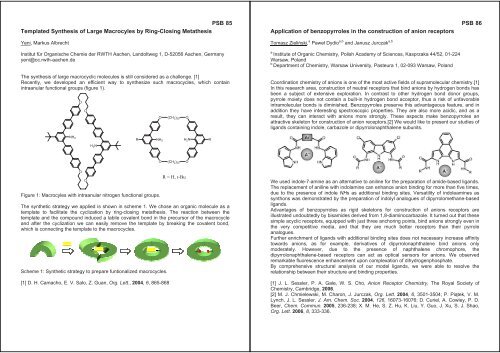ISMSC 2007 - Università degli Studi di Pavia
ISMSC 2007 - Università degli Studi di Pavia
ISMSC 2007 - Università degli Studi di Pavia
You also want an ePaper? Increase the reach of your titles
YUMPU automatically turns print PDFs into web optimized ePapers that Google loves.
PSB 85<br />
Templated Synthesis of Large Macrocyles by Ring-Closing Metathesis<br />
Yeni, Markus Albrecht<br />
Institut für Organische Chemie der RWTH Aachen, Landoltweg 1, D-52056 Aachen, Germany<br />
yeni@oc.rwth-aachen.de<br />
The synthesis of large macrocyclic molecules is still considered as a challenge. [1]<br />
Recently, we developed an efficient way to synthesize such macrocycles, which contain<br />
intraanular functional groups (figure 1).<br />
NH 2<br />
O<br />
O<br />
O<br />
O<br />
H 2N<br />
Figure 1: Macrocyles with intraanular nitrogen functional groups.<br />
The synthetic strategy we applied is shown in scheme 1. We chose an organic molecule as a<br />
template to facilitate the cyclization by ring-closing metathesis. The reaction between the<br />
template and the compound induced a labile covalent bond in the precursor of the macrocycle<br />
and after the cyclization we can easily remove the template by breaking the covalent bond,<br />
which is connecting the template to the macrocycles.<br />
Scheme 1: Synthetic strategy to prepare funtionalized macrocycles.<br />
[1] D. H. Camacho, E. V. Salo, Z. Guan, Org. Lett., 2004, 6, 865-868<br />
O<br />
R NH2 H2N R<br />
O<br />
(CH 2) 20<br />
(CH 2) 20<br />
R = H, t-Bu<br />
O<br />
O<br />
Application of benzopyrroles in the construction of anion receptors<br />
Tomasz Zieliski, a Pawe Dy<strong>di</strong>o a,b and Janusz Jurczak a,b<br />
a<br />
Institute of Organic Chemistry, Polish Academy of Sciences, Kasprzaka 44/52, 01-224<br />
Warsaw, Poland<br />
b<br />
Department of Chemistry, Warsaw University, Pasteura 1, 02-093 Warsaw, Poland<br />
PSB 86<br />
Coor<strong>di</strong>nation chemistry of anions is one of the most active fields of supramolecular chemistry.[1]<br />
In this research area, construction of neutral receptors that bind anions by hydrogen bonds has<br />
been a subject of extensive exploration. In contrast to other hydrogen bond donor groups,<br />
pyrrole moiety does not contain a built-in hydrogen bond acceptor, thus a risk of unfavorable<br />
intramolecular bonds is <strong>di</strong>minished. Benzopyrroles preserve this advantageous feature, and in<br />
ad<strong>di</strong>tion they have interesting spectroscopic properties. They are also more aci<strong>di</strong>c, and as a<br />
result, they can interact with anions more strongly. These aspects make benzopyrroles an<br />
attractive skeleton for construction of anion receptors.[2] We would like to present our stu<strong>di</strong>es of<br />
ligands containing indole, carbazole or <strong>di</strong>pyrrolonaphthalene subunits.<br />
We used indole-7-amine as an alternative to aniline for the preparation of amide-based ligands.<br />
The replacement of aniline with indolamine can enhance anion bin<strong>di</strong>ng for more than five times,<br />
due to the presence of indole NHs as ad<strong>di</strong>tional bin<strong>di</strong>ng sites. Versatility of indoleamines as<br />
synthons was demonstrated by the preparation of indolyl analogues of <strong>di</strong>pyrrolomethane-based<br />
ligands.<br />
Advantages of benzopyrroles as rigid skeletons for construction of anions receptors are<br />
illustrated undoubtedly by bisamides derived from 1,8-<strong>di</strong>aminocarbazole. It turned out that these<br />
simple acyclic receptors, equipped with just three anchoring points, bind anions strongly even in<br />
the very competitive me<strong>di</strong>a, and that they are much better receptors than their pyrrole<br />
analogues.<br />
Further enrichment of ligands with ad<strong>di</strong>tional bin<strong>di</strong>ng sites does not necessary increase affinity<br />
towards anions, as for example, derivatives of <strong>di</strong>pyrrolonaphthalene bind anions only<br />
moderately. However, due to the presence of naphthalene chromophore, the<br />
<strong>di</strong>pyrrolonaphthalene-based receptors can act as optical sensors for anions. We observed<br />
remarkable fluorescence enhancement upon complexation of <strong>di</strong>hydrogenphosphate.<br />
By comprehensive structural analysis of our model ligands, we were able to resolve the<br />
relationship between their structure and bin<strong>di</strong>ng properties.<br />
[1] J. L. Sessler, P. A. Gale, W. S. Cho, Anion Receptor Chemistry, The Royal Society of<br />
Chemistry, Cambridge, 2006.<br />
[2] M. J. Chmielewski, M. Charon, J. Jurczak, Org. Lett. 2004, 6, 3501-3504; P. Pitek, V. M.<br />
Lynch, J. L. Sessler, J. Am. Chem. Soc. 2004, 126, 16073-16076; D. Curiel, A. Cowley, P. D.<br />
Beer, Chem. Commun. 2005, 236-238; X. M. He, S. Z. Hu, K. Liu, Y. Guo, J. Xu, S. J. Shao,<br />
Org. Lett. 2006, 8, 333-336.

















